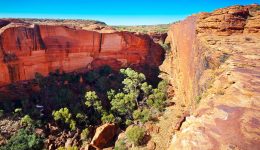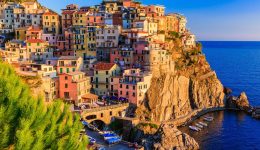Buses, Boats and Argentina’s Natural Beauty

Our passage to Argentina was the most incredible way to arrive at a new country. We began our journey from the Chilean town of Puerto Varas, a popular local holiday spot known for its German traditions. Staying at Hotel Bellavista, located right on Lake Llanquihue, we woke to the most serene sunrise over the lake, which gave off a beautiful soft violet hue. After a quick breakfast, we departed via bus to our first lakes crossing. The day is a combined journey of buses and boats crossing the most picturesque landscape, full of mountains, volcanoes, rivers and waterfalls. A definite highlight was Petrohué Falls. Rushing water fills the labyrinth of rivers surrounding the falls, with an incredible backdrop of the Osorno volcano. We also stopped at the town of Peulla, just before the Argentinian border. The town looks like it belongs in the Swiss mountains. After crossing into Argentina through the Andes mountains, we followed a winding road into Puerto Frias for another two boat trips and a final bus taking us into the town of Bariloche. Although you do spend most of the day getting on and off buses and boats it’s still a very peaceful journey, surrounded by nature and fresh air the whole time.
It’s definitely preferable to the 3 flights it would have taken.
San Carlos de Bariloche, usually shortened to Bariloche, is a beautiful town that feels very remote. Its location and German alps feel are popular with Argentinian tourists, and people from all over are keen to try the many adventure sports on offer. It feels like a big ski village as the surrounding mountains and lakes make for great winter activities. Almost 100 years ago the town centre was redesigned in the style of a European alpine town. Bariloche is also known for its chocolate, with plenty of cafes and chocolatiers around town to sample. For those not as adventurous or looking for a break from all the exploring, the town also has some lovely art and boutiques to browse, as well as an interesting history. From the early 1900’s the town had a thriving German population due to the Chilean governments German colonisation program. For a long time the town was dependant on Chile for importing supplies, until roads were built connecting them to the rest of Argentina.
Next up, my long-awaited visit to Buenos Aires! We chose to stay in San Telmo, a neighbourhood known for its bohemian vibe, full of bars, antique stores, and galleries. Our hotel, Anselmo, was located right on Plaza Dorrego, a beautiful tree lined square with cute cafes and restaurants with their chairs sprawled in the sunshine. Many visitors to Buenos Aires will include a tour of the world renowned Recoleta Cemetery. You can easily spend hours wandering around the thousands of ornate graves here. It’s a unique cemetery as the majority of the stone coffins are built into mausoleums that look like miniature buildings, housing generations of a family. You will find temples and cathedrals towering metres above you but once you look inside, they are only big enough for perhaps half a normal room size. Some crypts feature to scale marble statues of the people buried in them. There are many notable Argentinians buried within Recoleta and visiting their graves plus those that are particularly ornate, a whole morning will have flown. Some must see graves include Argentina’s own Evita, a young bride killed by an avalanche, and a 19-year-old buried alive.
You may know Milan’s Scala, or Paris’ Palais Garnier, but have you heard of Buenos Aires’ Teatro Colón? It is one of the most beautiful opera houses in the world, and known for its excellent acoustics, drawing artists to its stage since 1857, including the likes of Pavarotti. We took a tour of this stunning opera house, but unfortunately nothing was showing in the theatre during our stay. I’d highly recommend checking in advance before your visit to see if you can get tickets to a performance here. We were able to see a contemporary dance performance in the theatre’s basement. It felt very special with only 4 or 5 rows of seats, watching the dancers move between the supporting columns to the live piano and violin in the dim lighting was such a lovely way to spend an evening in this beautiful city.
Argentina is such a diverse country and I loved its contrasts.
I will be back again.
If you’d like to read more about Argentina – click here

















